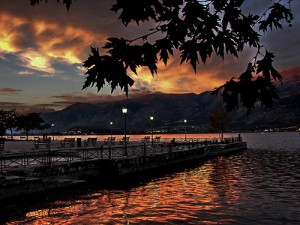Epirus
| Visa requirements | None |
|---|---|
| Languages spoken | Greek |
| Currency used | Euro |
| Area (km2) | 9.223 |
| Country name | Greece |
| Visa requirements | None |
|---|---|
| Languages spoken | Greek |
| Currency used | Euro |
| Area (km2) | 9.223 |
| Country name | Greece |
Mountains and gorges destined to be explored
High mountains and rushing rivers offer plenty of adrenaline-pumping excitement. You can kayak down the Aoos, top of the list in beauty and difficulty, raft the Voidomatis and the Arachthos rivers and hike the Acheron River in the summer. You can base jump from Profitis Ilias, walk the Vikos gorge, climb mountains and rocks or row in the Ioannina lake.
If you incline towards more sedate activities, there’s bird watching in the Amvracian Gulf, one of Europe’s most important wetlands. Whatever you decide, try to fit the following into your explorations: the Zagorohoria, the Aoos lake, Tzoumerka, the drive between Igoumenitsa and Metsovo on the new Egnatia highway, over the Katara pass, the highest in Greece that remains open all winter despite heavy snow.

Epirus is a region with few tourist places, therefore summer nightlife in Epirus is mostly restricted.
Parga and Sivota are the most popular summer destinations in Epirus with many taverns and lounge cafeterias along the portside. Parga, in particular, has most bars that stay open till the early hours. The region of Preveza also has some night bars due to its sandy beaches.
The most popular winter destination of Epirus is Zagoria. The villages of Zagoria are almost secluded from the rest of the region due to the tall mountains that surround them. They do not have bars or clubs, just some nice traditional taverns to enjoy a long dinner. The closest bars are found in the town of Ioannina, about 1 hour drive from Zagoria.

Immerse yourself in the local culture
The history of Epirus is unbelievably rich. You’ll seek it out at the magnificent archaeological site of Dodona with its famous ancient theatre, at Roman Nikopolis and at the Oracle at Efyra, renowned in antiquity. You’ll meet it also in Ioannina with its castle, Byzantine museum of Its Kale, eight Byzantine and post-Byzantine monasteries on the Island in the Lake. Monasteries abound in the Zagorohoria, too, with Agios Ioannis Rangovos and Agia Paraskevi being the most noteworthy.
Throughout Epirus you’ll admire the traditional workmanship in crafts of all kinds, from stone masonry to the delicate art of the silversmith. You’ll see it in the wonderful unspoilt villages, which have been called ‘poetry in stone’, like those in the Zagoria district, Metsovo, and Syrrako and Kalarrytes in the Tzoumerka range. And also in the arched stone bridges dotting the landscape: Kalogeriko at Kipi, Plaka, Konitsa and, the most famous of all, Arta. And, not least, in the silversmiths’ ateliers in Ioannina.

Unfortunately no tours were found.
